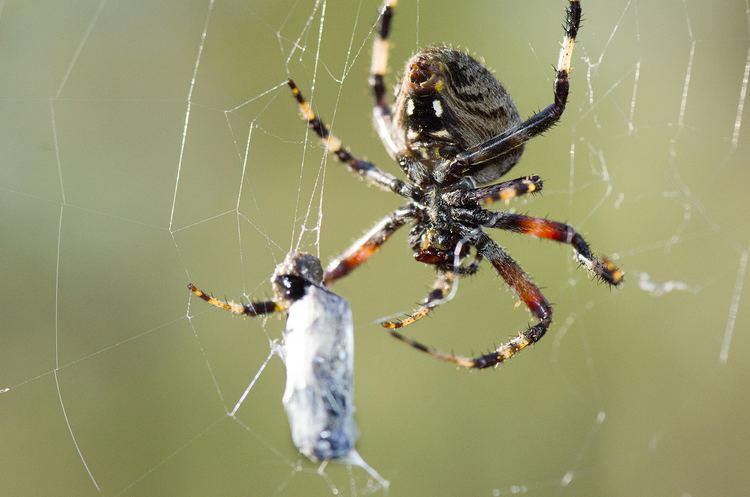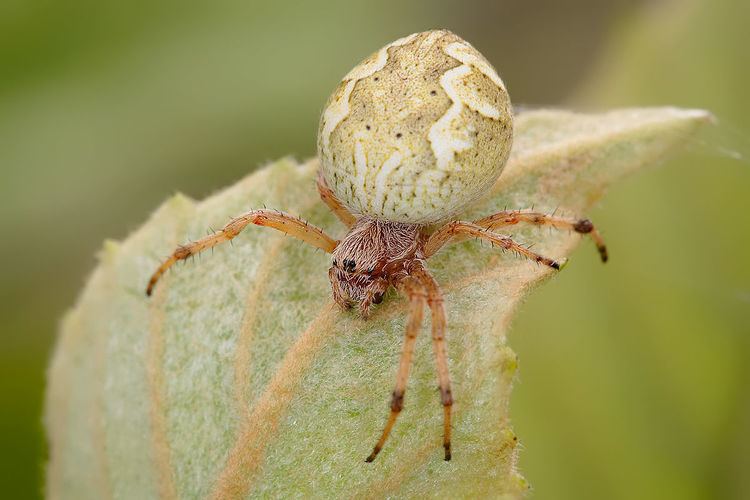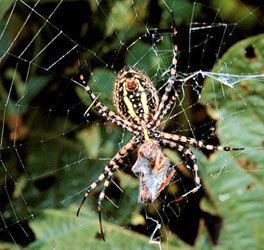Order Spider | Rank Family | |
 | ||
Lower classifications | ||
Orb-weaver spiders or araneids are members of the spider family Araneidae. They are the most common group of builders of spiral wheel-shaped webs often found in gardens, fields and forests. "Orb" was previously used in English to mean "circular", hence the English name of the group. Araneids have eight similar eyes, hairy or spiny legs, and no stridulating organs.
Contents

The family is cosmopolitan, including many well-known large or brightly colored garden spiders. With around 3,100 species in 169 genera worldwide, Araneidae is the third-largest family of spiders (behind Salticidae and Linyphiidae). Araneid webs are constructed in a stereotyped fashion. A framework of nonsticky silk is built up before the spider adds a final spiral of silk covered in sticky droplets.

Orb-webs are also produced by members of other spider families. The large golden orb-weavers (Nephilidae) and the long-jawed orb weavers (Tetragnathidae) were formerly included in the Araneidae; they are closely related, being part of the superfamily Araneoidea. It has recently been proposed that the family Arkyidae be split off from the Araneidae and the Nephilidae re-included, although as of October 2016 this has not been accepted by other sources. The cribellate or hackled orb-weavers (Uloboridae) belong to a different group of spiders. Their webs are strikingly similar, but use a different kind of sticky silk.

Web
Generally, orb-weaving spiders are three-clawed builders of flat webs with sticky spiral capture silk. The building of a web is an engineering feat, begun when the spider floats a line on the wind to another surface. The spider secures the line and then drops another line from the center, making a "Y". The rest of the scaffolding follows with many radii of nonsticky silk being constructed before a final spiral of sticky capture silk.
The third claw is used to walk on the nonsticky part of the web. Characteristically, the prey insect that blunders into the sticky lines is stunned by a quick bite, and then wrapped in silk. If the prey is a venomous insect, such as a wasp, wrapping may precede biting and/or stinging.
Many orb-weavers build a new web each day. Most orb-weavers tend to be active during the evening hours; they hide for most of the day. Generally, towards evening, the spider will consume the old web, rest for approximately an hour, then spin a new web in the same general location. Thus, the webs of orb-weavers are generally free of the accumulation of detritus common to other species, such as black widow spiders.
Some orb-weavers do not build webs at all. Members of the genera Mastophora in the Americas, Cladomelea in Africa, and Ordgarius in Australia produce sticky globules, which contain a pheromone analog. The globule is hung from a silken thread dangled by the spider from its front legs. The pheromone analog attracts male moths of only a few species. These get stuck on the globule and are reeled in to be eaten. Interestingly, both types of bolas spiders are highly camouflaged and difficult to locate.
The spiny orb-weaving spiders in the genera Gasteracantha and Micrathena look like plant seeds or thorns hanging in their orb-webs. Some species of Gasteracantha have very long, horn-like spines protruding from their abdomens.
One feature of the webs of some orb-weavers is the stabilimentum, a crisscross band of silk through the center of the web. It is found in a number of genera, but Argiope, the yellow and banded garden spiders of North America, is a prime example. The band has been hypothesized to be a lure for prey, a marker to warn birds away from the web, and a camouflage for the spider when it sits in the center of the web. However, recent research suggests the stabilimentum actually decreases the visibility of the silk to insects, thus making it harder for prey to avoid the web. The orb-web consists of a frame and supporting radii overlaid with a sticky capture spiral, and the silks used by orb-weaver spiders have exceptional mechanical properties to withstand the impact of flying prey.
During the Cretaceous, a radiation of angiosperm plants and their insect pollinators occurred. Fossil evidence shows that the orb web was in existence at this time, which permitted a concurrent radiation of the spider predators along with their insect prey. The capacity of orb–webs to absorb the impact of flying prey led orbicularian spiders to become the dominant predators of aerial insects in many ecosystems. Insects and spiders have comparable rates of diversification, suggesting they co-radiated, and the peak of this radiation occurred 100 Mya before the origin of angiosperms. Vollrath and Selden (2007) make the bold proposition that insect evolution was driven less by flowering plants than by spider predation – particularly through orb webs – as a major selective force.
Most arachnid webs are vertical and the spiders usually hang with their head downward. A few webs, such as those of orb-weavers in the genus Metepeira have the orb hidden within a tangled space of web. Some Metepiera are semisocial and live in communal webs. In Mexico, such communal webs have been cut out of trees or bushes and used for living fly paper. In 2009, workers at a Baltimore Wastewater Treatment Plant called for help to deal with over 100 million orb-weaver spiders, living in a community that managed to spin a phenomenal web that covered some 4 acres of a building with spider densities in some areas reaching 35,176 spiders per cubic meter.
Natural history
The oldest known true orb-weaver is Mesozygiella dunlopi, from the Lower Cretaceous. Several fossils provide direct evidence that the three major orb-weaving families, namely Araneidae, Tetragnathidae and Uloboridae, had evolved by this time, about 140 million years ago. They probably originated during the Jurassic (200 to 140 million years ago). Based on new molecular evidence in silk genes, all three families are likely to have a common origin.
The two families, Deinopoidea and Araneoidea, have similar behavioral sequences and spinning apparatuses to produce architecturally similar webs. The Araneidae weave true viscid silk with an aqueous glue property, and the Deinopoidea use dry fibrils and sticky silk. The Deinopoidea (including the Uloboridae), have a cribellum – a flat, complex spinning plate from which the cribellate silk is released.
They also have a calamistrum – an apparatus of bristles used to comb the cribellate silk from the cribellum. The Araneoidea, or the "ecribellate" spiders, do not have these two structures. The two families of orb-weaving spiders are morphologically very distinct, yet there is much similarity between their web form and web construction behavior. The cribellates retained the ancestral character, yet the cribellum was lost in the escribellates. The lack of a functional cribellum in araneoids is most likely synapomorphic.
If the orb-weaver spiders are a monophyletic group, the fact that only some species in the group lost a feature adds to the controversy. The cribellates are split off as a separate taxon that retained the primitive feature, which makes the lineage paraphyletic and not synonymous with any real evolutionary lineage. The morphological and behavioral evidence surrounding orb webs led to the disagreement over a single origin or a dual origin. However, molecular analysis provides more support for a monophyletic origin.
Reproduction
Araneids species either mate at the central hub of the web, where the male slowly traverses the web, trying not to get eaten, and when reaching the hub, mounts the female; or the male constructs a mating thread inside or outside the web to attract the female via vibratory courtship, and if successful, mating occurs on the thread.
In the cannibalistic and polyandrous orb-web spider Argiope bruennichi, the much smaller males are attacked during their first copulation and are cannibalized in up to 80% of the cases. All surviving males die after their second copulation, a pattern observed on other Argiope species. Whether a male survives his first copulation depends on the duration of the genital contact: males that jump off early (before 5 seconds) have a chance of surviving, while males that copulate longer (greater than 10 seconds) invariably die. Prolonged copulation, although associated with cannibalism, enhances sperm transfer and relative paternity.
It was observed that when males mated with a non-sibling female, the duration of their copulation was prolonged, and consequently the males were cannibalized more frequently. When males mated with a sibling female, they copulated briefly, and thus were more likely to escape cannibalism. By escaping, their chance of mating again with a non-kin female likely would be increased. These observations suggest that males can adaptively adjust their investment based on the degree of genetic relatedness of the female in order to avoid inbreeding depression.
Sexual Size Dimorphism
Sexual dimorphism refers to physical differences between males and females of the same species. One such difference can be in size.
Araneids often exhibit size dimorphism typically known as extreme sexual size dimorphism, due to the extent of differences in size. The size difference among species of Araneidae ranges greatly. Some females, such as those of the Nephila pilipes, can be at least 9 times larger than the male, while others are only slightly larger than the male. The larger size female is typically thought to be selected through fecundity selection, the idea that bigger females can produce more eggs, thus more offspring. Although a great deal of evidence points towards the greatest selection pressure on larger female size, there is some evidence that selection can favor small male size as well.
Araneids also exhibit a phenomenon called sexual cannibalism, which is commonly found throughout Araneidae. Evidence suggests a negative correlation between sexual size dimorphism and incidences of sexual cannibalism. Other evidence, however, has shown that differences in cannibalistic events among araneids when having smaller or slightly larger males is advantageous.
Some evidence has shown that extreme dimorphism may be the result of males avoiding detection by the females. For males of these species, being smaller in size may be advantageous in moving the central hub of a web so female spiders may be less likely to detect the male, or even if detected as prey to be eaten, the small size may indicate little nutritional value. Larger–bodied male araneids may be advantageous when mating on a mating thread because the thread is constructed from the edge of the web orb to structural threads or to nearby vegetation. Here larger males may be less likely to be cannibalized, as the males are able to copulate while the female is hanging, which may make them safer from cannibalism. In one subfamily of Araneid that uses a mating thread, Gasteracanthinae, sexual cannibalism is apparently absent despite extreme size dimorphism.
Systematics
As of December 2015, the World Spider Catalog placed 169 genera (comprising over 3,000 species) in the family Araneidae.
The Nephilidae were elevated to family status in 2006. Some researchers also consider the genera Leviellus, Parazygiella, Stroemiellus and Zygiella to reside in the family Zygiellidae.
